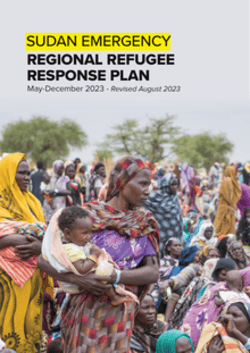Regional Overview

The magnitude of displacement within Sudan and into neighbouring countries has continued to increase since the devastating conflict erupted in Sudan in mid-April 2023, with 3.6 million internally displaced in Sudan by the end of August, and more than 1 million refugees, returnees and third country nationals having arrived in the neighbouring countries of the Central African Republic (CAR), Chad, Egypt, Ethiopia, and South Sudan.
This August 2023 revision of the Regional Refugee Response Plan (RRP) for the Sudan emergency extends the original six-month Plan through the end of the year and reflects the updated population planning figures (increased from a total of 1.2 million to 1.8 million refugees, returnees and third country nationals), and increased financial requirements (increased from total requirements of USD 556 million to USD 1.005 billion).
The dramatic increase in financial requirements (particularly in Chad and South Sudan, with smaller increases in Egypt and Ethiopia) reflects the extended timeframe, higher projected arrivals in several countries (particularly South Sudan and Chad), new partners involved in the response, and varied needs of different population groups. While the overall objectives of the RRP remain the same, adjustment to the response approach have been made where relevant. The revised Regional RRP also highlights the prominent role that the governments and their different ministries play in the response in the five countries.
In Sudan, hostilities have been continuous since the outbreak of fighting. The relentless fighting in Khartoum, catastrophic resumption of intercommunal violence in the Darfur region, and spread of the conflict to the Kordofan and other parts of the country has trapped civilians and made many areas inaccessible for desperately needed humanitarian assistance to be safely delivered. Access to health care has been critically impacted by the conflict, with direct attacks on healthcare facilities as well as severe shortages of medicines and vital supplies. Humanitarian assets continue to be looted in areas affected by the conflict. The humanitarian situation remains dire with pervasive food, water and fuel shortages, limited access to communication and electricity, and skyrocketing prices for essential items.
The insecurity, cost of fuel and transport, as well as family separation, make it difficult for people to leave conflict-affected areas and move to safer locations, whether within Sudan or across borders. The crisis comes on top of an already challenging humanitarian situation in Sudan; almost 16 million people were already estimated to need humanitarian assistance in 2023.
Those fleeing Sudan have been arriving in remote border locations where RRP partners have been receiving new arrivals, providing critical lifesaving assistance and facilitating onward movement in extremely difficult conditions. The border regions of CAR, Chad, and South Sudan are normally dependent on cross-border trade with Sudan and the conflict has had a substantial economic impact, increasing the burden on hosting communities and increasing the cost of the humanitarian response. The need to improve infrastructure and conditions in transit centres and refugee camps and settlements remains urgent and expensive. As many families have been on the move for weeks – with very little food or medicine – rising malnutrition rates, disease outbreaks and related deaths are of great concern. RRP partners are doing everything they can to respond but more funding is desperately needed.
Countries neighbouring Sudan impacted by this new emergency were already hosting large refugee, migrant and internally displaced populations before the crisis. Recent refugee arrivals to Chad add to the more than 400,000 Sudanese refugees who have been in a protracted situation in eastern Chad for some 20 years. In South Sudan, 76 per cent of the population were already estimated to be in need of aid. Humanitarian programmes in these countries were already, and remain severely underfunded.
Receiving and hosting countries have, nevertheless, for the most part opened their borders to those seeking safety. They need international support to sustain this generosity, including from development actors to accompany the initial humanitarian response with investments to strengthen basic services and socio-economic inclusion for refugees and host communities in integrated settlements, and in areas of return. Proactive engagement with development actors is underway, to complement and build on the response under the RRP.
In addition to the Sudanese and refugees of other nationalities, as well as refugee returnees, crossing into neighbouring countries, there are also migrant returnees and third country nationals (TCNs).
Migrant returnees are arriving in vulnerable conditions and require humanitarian and protection assistance upon arrival, as well as onwards assistance. TCNs, who are not nationals of the country in which they arrive, may wish to return to their countries of origin. However, they often face challenges linked to the availability and accessibility of consular services, proper documentation, transportation means and conditions of dignified return and reintegration in their countries of origin. IOM is the lead agency supporting migrant returnees and TCNs who do not have international protection needs, together with government counterparts and relevant RRP sectors, ensuring complementarity across the response. UNHCR and IOM are working side by side at several border crossings to help all people fleeing Sudan, to identify the different population groups leaving the country, register those in need of protection, and identify the most vulnerable.
In line with the Global Compact on Refugees, this inter-agency RRP aims to support the host countries in the region to lead and coordinate the response to the refugee outflow. The RRP is undertaken in accordance with the Refugee Coordination Model (RCM) and outlines the multi-partner, multi-sector response strategy and financial requirements of 64 partners in CAR, Chad, Egypt, Ethiopia and South Sudan, to provide protection services and urgent humanitarian assistance to refugees, returnees and third country nationals, together with impacted host communities. The RRP has been developed by partners – including UN Agencies, national societies of the Red Cross and Red Crescent, national and international non-governmental organizations, faith-based organizations and civil society, and builds on the collective and coordinated work already being done in these countries, much of it government-led, and promotes an area and a needs-based approach.

